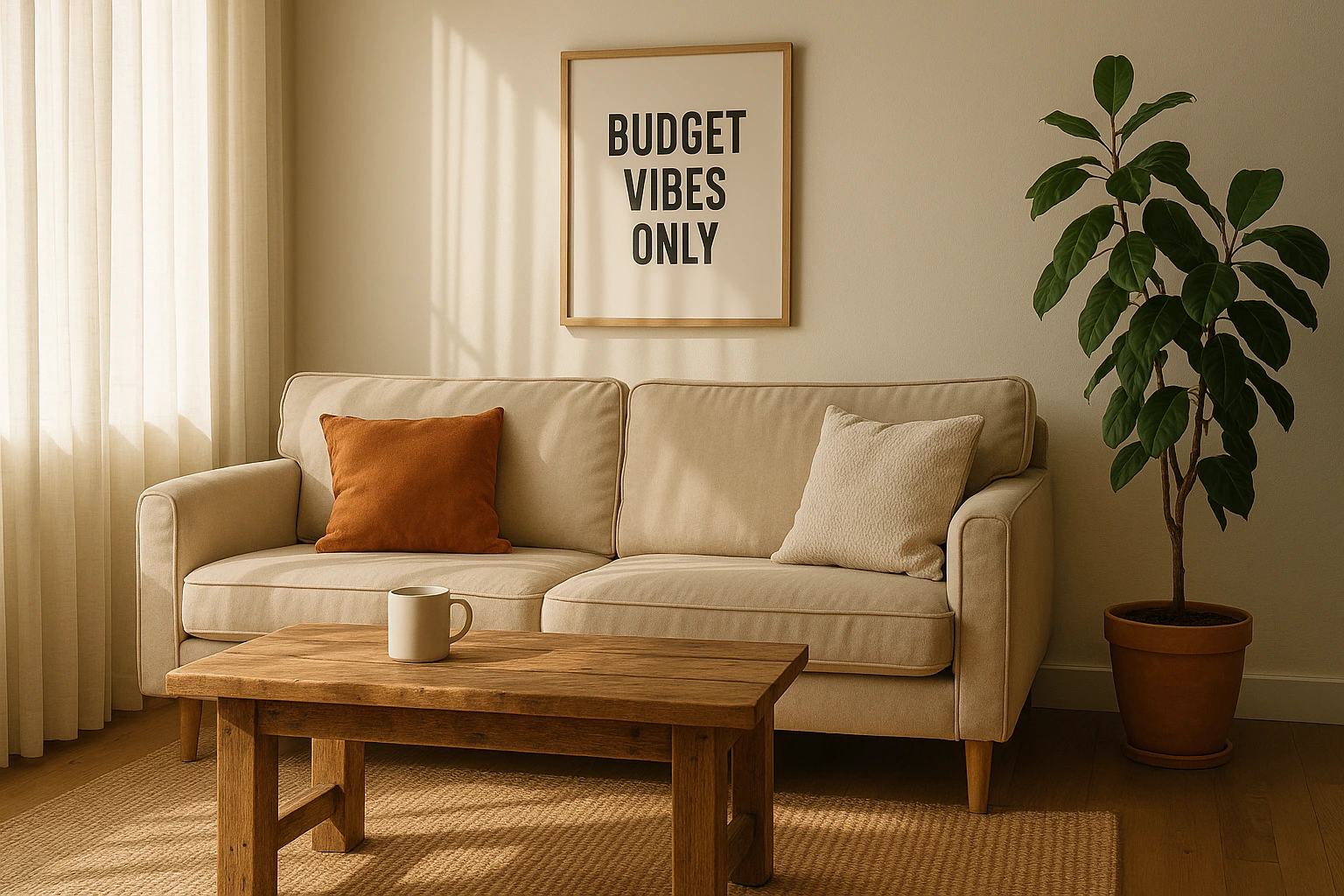
Hey there—new homeowner or renter? Sticker shock is real—but with frugal home furnishing, you can still create a stylish, comfy space. Take Sarah: she turned a tiny apartment into a gem for under $1,000 using thrift store furniture tips and a few quick DIYs. This isn’t just about pinching pennies; it’s smart living—an essential part of frugal living that extends to every room. In this 2025 guide, you’ll get practical tricks and the best spots to shop without emptying your wallet.
Try Our Budget Calculator Now!Table of Contents
- Key Takeaways for Budget Decorating
- Mindset: Decorating Smart on a Budget
- Room-by-Room Budget Decorating
- Thrifting Tips for Furniture
- How to Blend Thrifted and New Pieces
- DIY Projects to Personalize Your Space
- Best Online Marketplaces for Deals
- Top Budget-Friendly Retailers
- Tips to Avoid Impulse Buys
- Furnishing Budget Calculator
- Frequently Asked Questions
- Conclusion: Your Affordable Decorating Journey
Key Takeaways for Frugal Home Furnishing
- Use smart thrifting to find durable, unique pieces for less.
- Go for high-value finds first (solid-wood tables, vintage chairs) and pass on anything wobbly or musty.
- Mix your thrift finds with a few new basics—think a Wayfair sofa with a vintage coffee table—so the room feels intentional, not mismatched.
- Pick one or two quick DIYs (paint a dresser, swap the hardware) and repurpose what you already own—that’s where the personality and savings show up.
- Start with the rooms you use daily—the living room and bedroom—then circle back to the rest as the budget loosens.
- Set a short list with price caps and sleep on big buys for 24 hours—impulse-proof and cheaper.
The Mindset That Makes Budget Decorating Work
Before you shop, get clear on what matters—and what you can skip. Aim for choices that fit your style and your wallet. Here’s a quick primer.
Define Your Style—and Your Must-Haves
Close your eyes and picture your place at its best—colors, textures, and the few pieces you can’t live without. Save examples to a quick mood board so you don’t buy off-plan. Scroll through Instagram or Pinterest for inspo, or even tear pages out of a decor magazine. This keeps you focused and stops you from buying stuff that doesn’t match. Then, think about what you really need. Love having friends over? A big dining table might be your thing. Working from home? You’ll want a sturdy desk. Knowing what matters most helps you spend smart on affordable home decor, just like you’d plan for budget-friendly meal planning or smart grocery shopping.
Create a Realistic Budget
Give every dollar a job. With a $1,000 budget, try $400 for a sofa, $300 for a mattress, and use the rest for paint and small fixes. Track it in Mint or YNAB. A good budget doesn’t box you in—it lets you choose what matters.
“A good budget doesn’t hold you back—it frees you to spend on what counts.”
Prioritize, Then Plan the Buys
Start with the big pieces first—a sofa and coffee table—then layer in rugs, lighting, and art. Spread out your buys over a few months if you need to—it’s a great way to keep your affordable decorating plan stress-free and on track.
This post contains affiliate links. If you buy through our links, we may earn a commission at no extra cost to you. Learn more.
Decorating Each Room on a Budget
With your plan ready, let’s get into the fun part: room-by-room ideas for budget-conscious decorating that mix style, function, and serious savings.
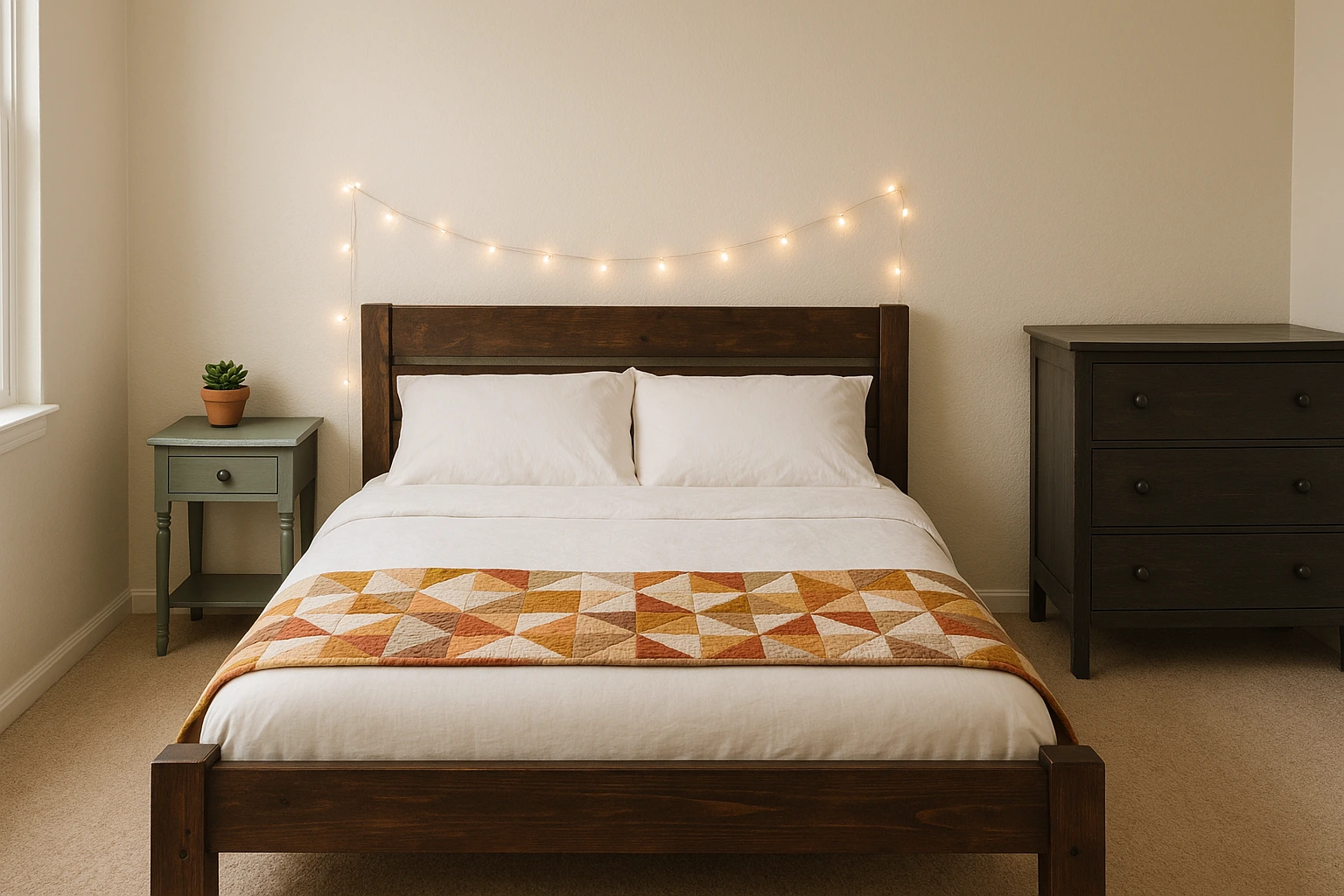
Living Room: Crafting a Cozy Hub
This is where you crash after work and host friends. Try a bold thrifted rug with a clean-lined Wayfair sofa for balance. Sarah scored a mid-century sofa for $150 and freshened it with a $50 slipcover. Here’s how to keep it cost-effective in your living room:
- Sofa: Hunt for a used sofa in good shape and add a slipcover. Or hit Wayfair’s major sales, where sofas often drop under $400 (varies by brand and timing). Savings Example: Thrifted sofa ($150 + $100 slipcover) vs. New ($800+).
- Coffee Table: DIY one from reclaimed wood or a flea market trunk. Savings Example: DIY table (~$50) vs. new (~$200+).
- Accent Chairs: Flea markets have unique chairs with solid frames for cost-conscious home design, often under $50.
- Rugs: Grab washable rugs from Wayfair, starting at $30, for style and easy cleaning.
- Decor: Sprinkle in some throw pillows, thrifted artwork, and a couple of leafy plants for a warm, lived-in vibe.
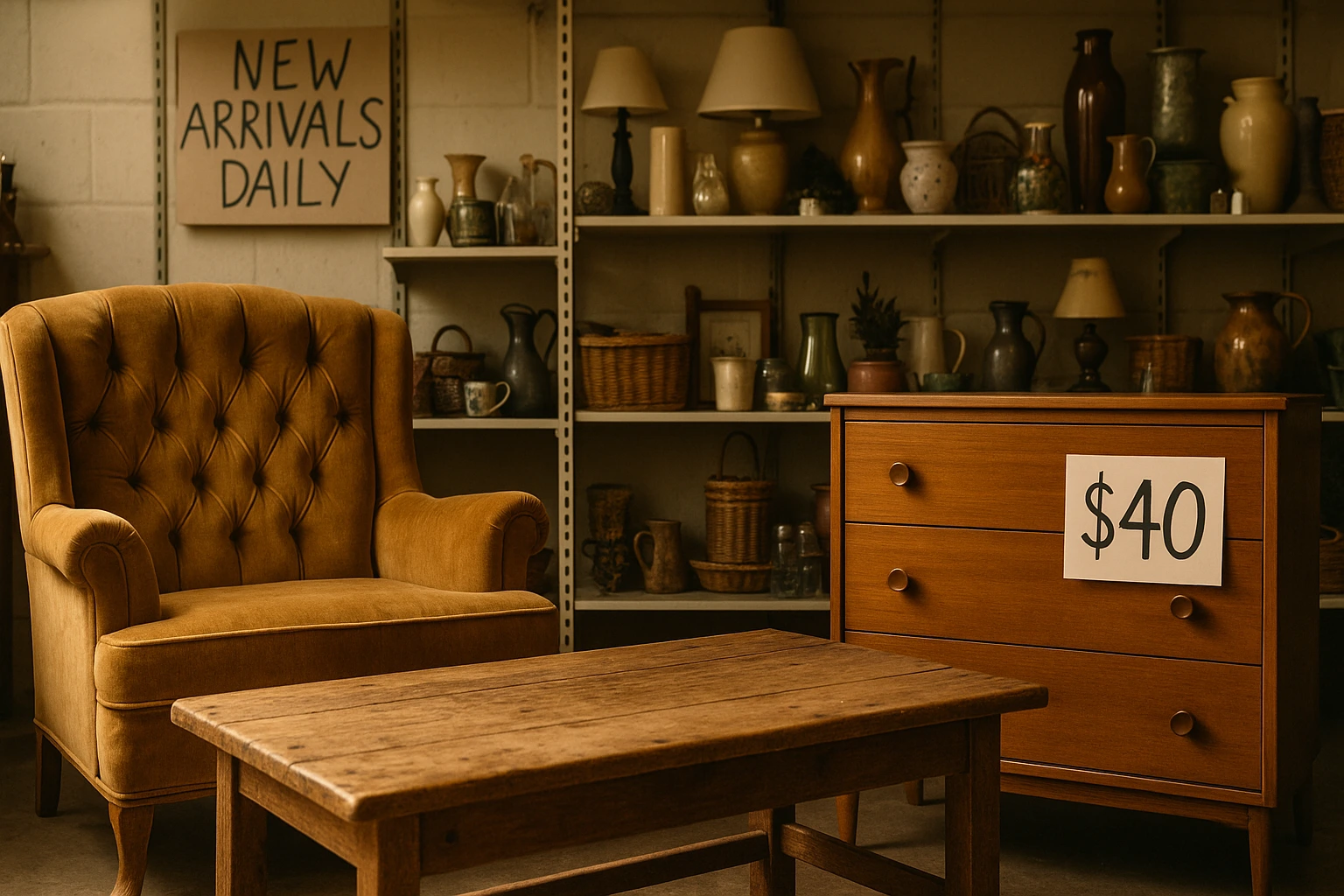
Bedroom: Your Budget-Friendly Sanctuary
Your bedroom should feel like a peaceful escape. Think a simple platform bed with soft string lights and a refinished dresser for a touch of charm. A thrifted wooden bed frame might only set you back $80 on Craigslist. Here’s how to pull off affordable furnishing in your bedroom:
- Bed Frame: Check Facebook Marketplace or estate sales for used platform beds. Savings Example: Used frame ($80) vs. New ($300+).
- Mattress: Splurge a bit on a comfy mattress during holiday sales from Casper or Zinus—watch for 15–30% off. Sleep’s worth it!
- Dresser: Refinish a thrift store wood dresser for your low-cost furnishing project, about $60 with paint.
- Nightstands: Repurpose small tables or snag budget ones from Target for under $50.
- Lighting: String lights or IKEA lamps, starting at $10, add a warm glow.
Dining Room: Gathering in Style
The dining room’s where you make memories over meals. Sarah scored a rustic table for $100 on Craigslist and paired it with mismatched chairs for a cool, eclectic look. Here’s how to do economical decorating in your dining room:
- Dining Table: Build one from reclaimed wood or check Bed Bath & Beyond end-of-season sales. Savings Example: DIY table ($100) vs. Store-bought ($400+).
- Chairs: Mix thrifted chairs for a unique vibes, often $10–20 each at Goodwill.
- Tableware: Hit dollar stores or thrift shops for plates starting at $1.
- Centerpiece: Use candles or natural bits like branches for a chic, low-cost touch.
Home Office: Productivity on a Budget
Let’s be real: a home office needs to work as hard as you do without costing a fortune. A thrifted desk with an ergonomic chair can keep you focused. Sarah found a vintage desk for $40 and painted it to match her style. Here’s how to set up your office with budget-friendly furnishing:
- Desk: Look on Craigslist or build one with IKEA parts. Savings Example: Used desk ($50) vs. New ($200+).
- Chair: Watch Wayfair’s Memorial Day sale—solid ergonomic picks often dip under $100.
- Storage: Thrifted shelves or sturdy baskets usually run $10–$20 and tame the paper pile.
- Lighting: Add a task lamp (Amazon Basics starts around $15) so you’re not working in the dark.
- Decor: Finish with a small plant or a thrifted print—easy wins under $10.
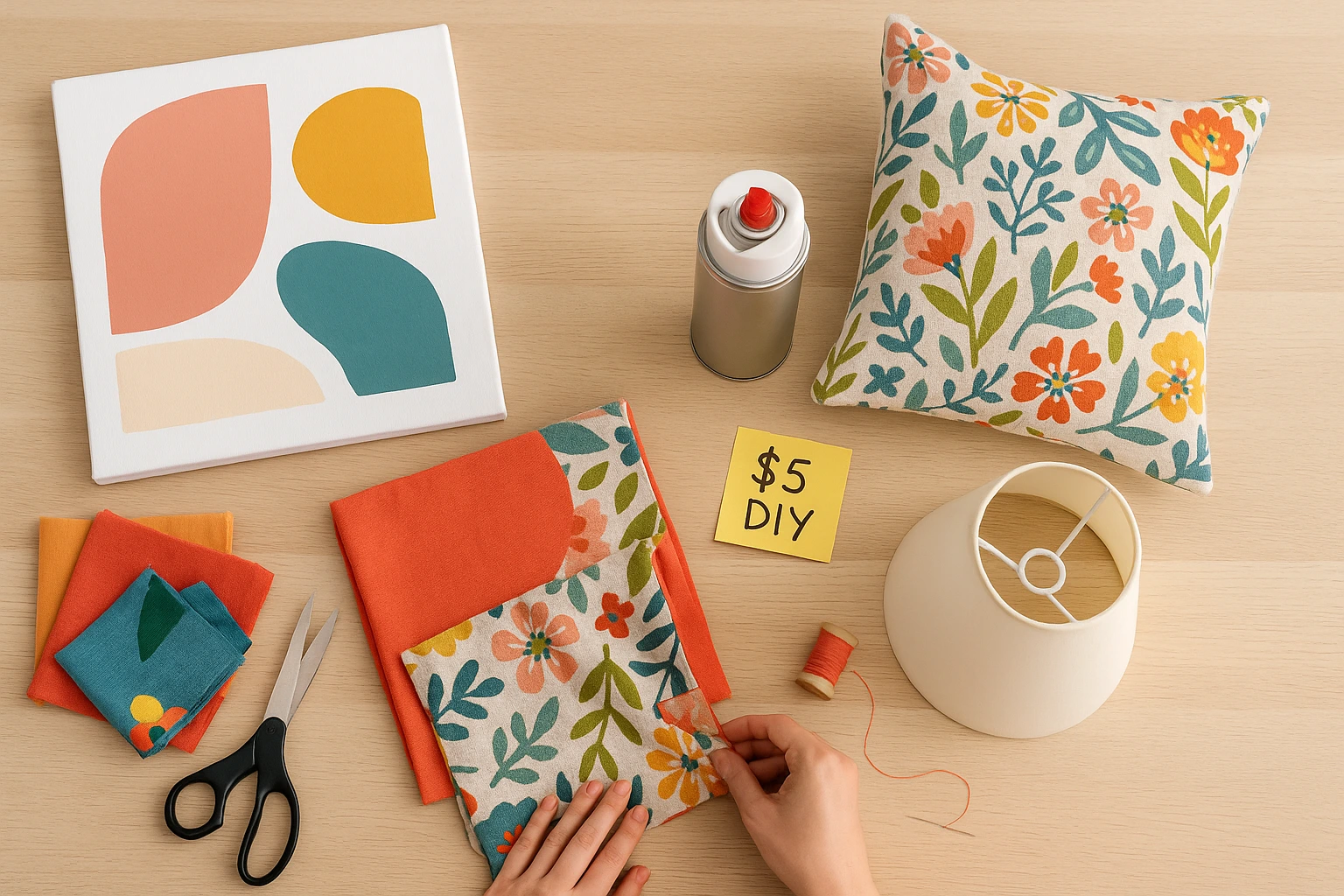
Thrift Store Furniture Tips
Thrifting stretches a budget fast. Emma outfitted her living room with a $75 sofa and a $20 coffee table—money saved and less waste. It’s kinder to your wallet and the planet. For eco-friendly upkeep, see our guide on frugal cleaning hacks to keep pieces looking good.
Follow these thrifting tips for furniture to find high-quality pieces that fit your style and budget.
- Go Often: Swing by thrift stores weekly—new stuff like vintage armchairs shows up all the time.
- Look Beyond the Surface: Don’t sweat ugly finishes; focus on a piece’s shape and DIY potential.
- Inspect Carefully: Check for wobble, loose joints, strong odors, and stains. Avoid upholstered items with signs of bedbugs (look for dark specks in seams/tufts).
- Older Paint Warning: If a piece looks pre-1978, assume the finish may contain lead. Consider hiring a lead-safe certified pro (EPA RRP) and avoid dust-creating methods like dry sanding or grinding; follow local rules. Learn more from the EPA.
- Negotiate: Haggle a bit, especially if something’s not perfect, to score a better deal.
- Repurpose: Turn a dresser into a bathroom vanity or a suitcase into a side table for one-of-a-kind affordable home decor solutions.
Bedbug check: look for dark/excrement spots, stains, shed skins, and live insects along seams/tufts and nearby cracks. When in doubt, skip upholstered items or have them inspected.
“Thrifting isn’t only about saving money—it’s how you find one-of-a-kind pieces and give them a second life.”
Spotting Quality in Thrifted Furniture
Quality first. When you’re hunting for budget-conscious furnishing, check these basics:
- Solid Wood: Beats particleboard for durability and long-term use.
- Dovetail Joints: Check drawer corners for tight, interlocking cuts—an easy sign of solid craftsmanship and long life.
- Sturdy Frame: Set it on a flat floor and rock it; if it wobbles or creaks, the joints are loose—keep looking.
- Comfortable Seating: Sit for a full minute; if it sags, pinches behind your knees, or squeaks, skip it.
Mixing Old and New in Frugal Home Furnishing
Want a space that reads pulled together? Anchor with one new piece (say, a modern Wayfair rug) and layer in a thrifted chair or table. The mix looks collected, not matchy-matchy. Here’s how:
- Statement Pieces: Start with one thrifted piece you love—a sofa or a table—and build around it.
- Mix Styles: Blend eras—mid-century lines with modern lighting—for character without clutter.
- Color Palette: Stick to a consistent palette to tie everything together.
- Personal Touches: Add photos or DIY art to make the space feel like home.
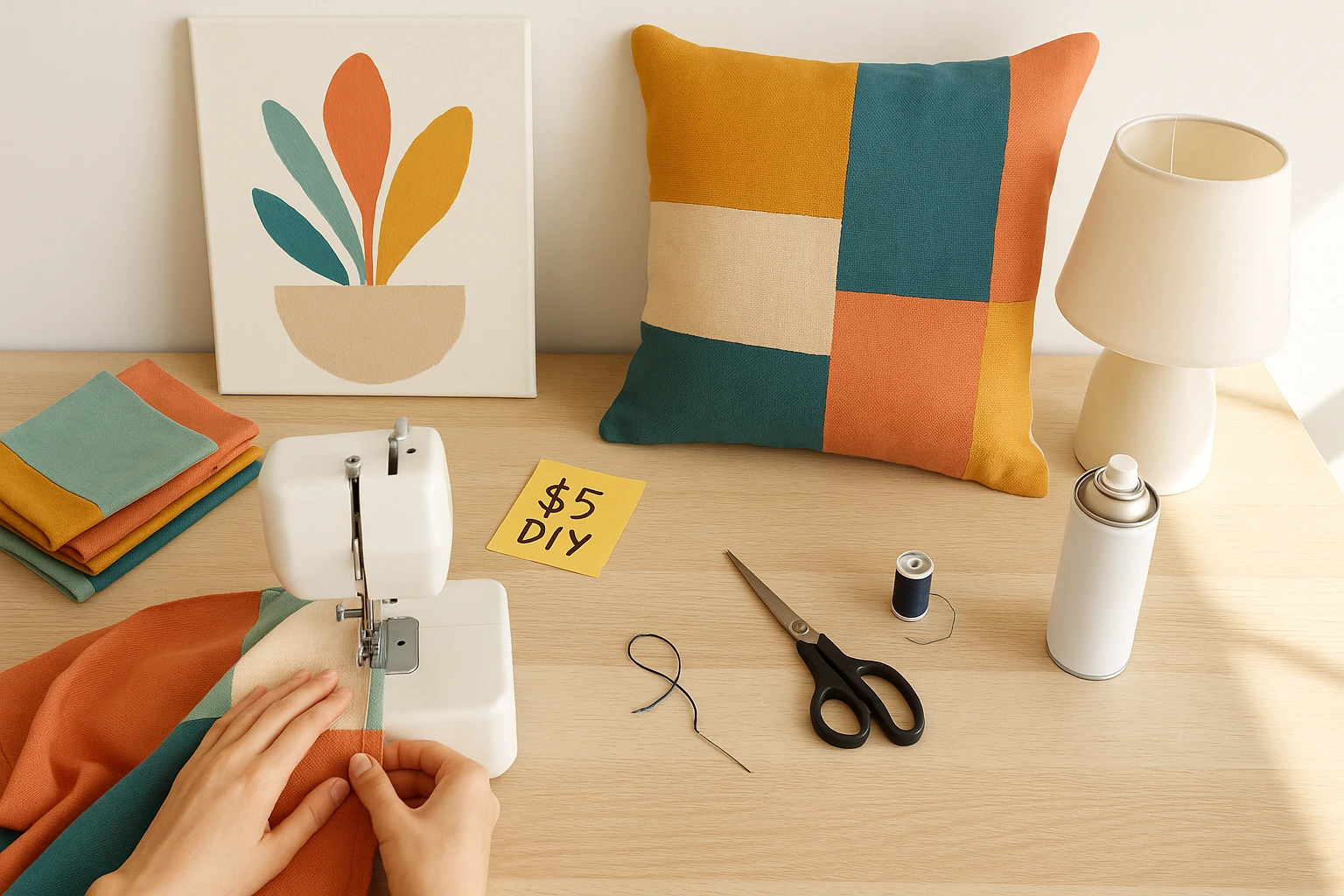
DIY Home Decor Projects That Save You Money
DIY is where affordable decorating pays off. Sarah stripped, sanded, and repainted a thrifted dresser, then made wall art from $5 canvases—cheap moves with big impact. Want free or low-cost supplies? Check our best freebies for frugal living. Try these:
- Wall Art: Paint canvases, use stencils, or frame fabric scraps for under $10.
- Throw Pillows: Sew pillows from old clothes or fabric scraps, costing $5–10.
- Curtains: Whip up curtains from $15 cotton at a craft store.
- Lampshades: Refresh old shades with spray paint or fabric for $5.
- Floating Shelves: Build shelves from reclaimed wood for $20 to show off books or plants.
- Picture Frames: Paint thrifted frames for a gallery wall; thrifted frames usually run $2–$5 each.
Paints/solvents: use in a well-ventilated area, wear protection, and follow product labels.
Best Online Marketplaces for Affordable Furniture Finds
Thrift stores are great, but don’t skip Facebook Marketplace. It’s packed with small-space deals if you move fast. Shop smart:
- Set Alerts: Save searches for items you want—desks, sofas, shelves—and let alerts do the hunting.
- Haggle: Offer a fair number with pickup today; most sellers drop the price for speed.
- Inspect: Meet in daylight, check joints and seams, and only pay after a quick sit/rock test.
- Transport: Plan how to move big stuff—rates vary by city and season, so grab 2–3 quick quotes or check local van rentals.
Top Budget-Friendly Retailers
Sometimes you want new. These stores keep cost-effective furnishing simple:
- Wayfair: Big selection with frequent promo codes—watch Black Friday and clearance.
- IKEA: Starter pieces from ~$20; easy to hack and replace parts.
- Amazon Basics: No-frills staples (lamps from around $15–$30); check dimensions and reviews.
- Target: Threshold/Project 62 lines often drop pillows/rugs to budget prices.
- Bed Bath & Beyond: Look for rotating discounts and closeouts.
- Etsy: Handmade/upcycled finds; confirm lead time and shipping upfront.
Tips to Avoid Impulse Buys
Staying on track with your budget-friendly decorating budget takes a bit of discipline. For extra motivation, check out our daily habit quotes to stay focused. Here’s how to keep impulse buys at bay:
- Stick to Budget: Don’t go over your limit for any room or item.
- Take Time: Slow down and make sure purchases fit your plan.
- Sleep on It: Wait a night before committing to big buys.
- Seek Opinions: Run major purchases by friends or family.
- Avoid Stress Shopping: Steer clear of shopping when you’re feeling stressed or overwhelmed.
Furnishing Budget Calculator
Wondering if your budget can bring your space to life without overspending? Set your budget, choose a room, and get a quick read on how far it’ll go—plus tips to stretch every dollar.
Frequently Asked Questions
I’ve furnished my place on a tight budget by hitting thrift stores for gems like a $75 sofa. Mixing DIY projects, like painting old furniture, with sales at Wayfair or IKEA keeps costs low. It’s all about planning and prioritizing key pieces!
You’ll save most by buying secondhand and negotiating kindly. Search Craigslist or Facebook Marketplace, compare a few listings, and bring cash for quick pickup. Add simple DIYs—like sewing pillow covers—and time big purchases around sales at Target or IKEA. You’ll stretch your budget without sacrificing comfort.
Plan for $1,000–$2,000 to start, focusing on a mattress, sofa, and basic lighting. Tackle one room at a time so you’re not overwhelmed. Mix thrifted finds with a few new staples, and track every purchase. With a list and patience, you’ll build a comfortable home without overspending.
Soft home furnishing covers textiles and accents—curtains, throws, pillows, rugs—that add comfort and color. You can keep costs low by sewing simple panels, buying washable rugs on sale, and thrifting pillow inserts. Small swaps like these make rooms feel cozy fast without a big price tag.
Conclusion: Your Affordable Decorating Journey
Plan a little, make a few simple upgrades, and shop with a list—thrifty home decorating becomes doable and fun. Thrift the big pieces, add one DIY win, and fill gaps with a couple of budget retailers. Use smart thrifting tips for furniture to find the character pieces, then call it done. You’ve got this—have fun with it! 🎉
For more ways to save across all areas of your life, dive into our Frugal Living Handbook: Save More in Every Area of Life for practical tips and strategies.